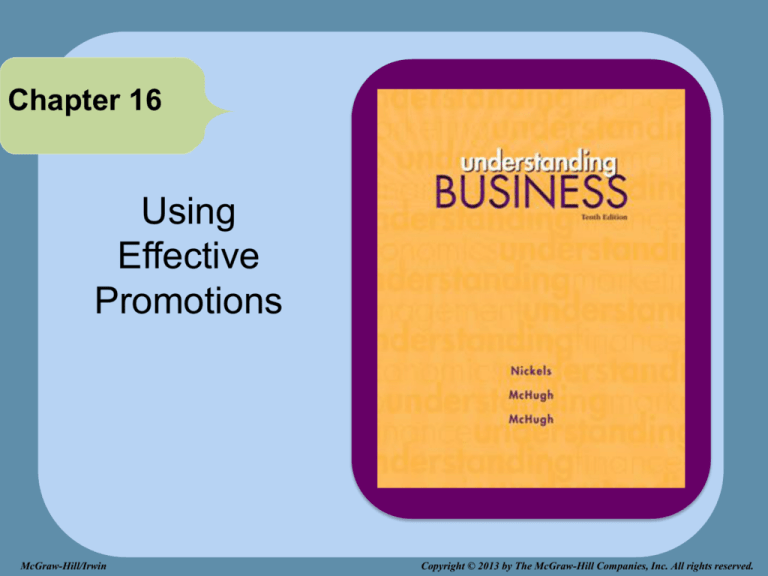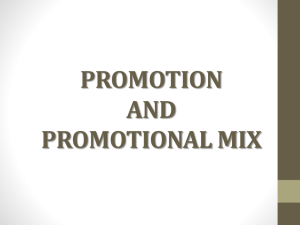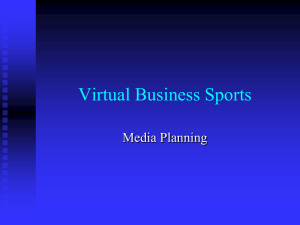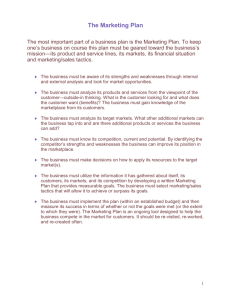
Chapter 16
Using
Effective
Promotions
McGraw-Hill/Irwin
Copyright © 2013 by The McGraw-Hill Companies, Inc. All rights reserved.
PROMOTION
in an ORGANIZATION
• Promotion Mix -- The combination of promotional
tools an organization uses. The traditional mix
includes:
16-2
ADVERTISING
16-3
ADVERTISING in the FIRM
• Advertising -- Paid, nonpersonal communication
through various media by
organizations and individuals
who are in some way
indentified in the message.
• Major goals of advertising:
- Inform
- Persuade
- Remind
16-4
IMPACT of ADVERTISING
• Total advertising expenditures
exceed $241 billion yearly.
• Consumers benefit because
production costs of TV
programs, radio programs,
newspapers and magazines
are paid for by advertisers.
• Marketers choose ad media
that will reach the target
market.
16-5
SOCIAL ADVERTISING
• Social media advertising
is growing so fast,
marketers can’t keep up.
• Starbucks has over 12
million followers on
Twitter.
• McDonald’s has over 7
million fans on Facebook.
16-6
MATCH GAME
Match the Company with the Slogan
• “Everybody doesn’t like something, but nobody
doesn’t like ___________.”
• “It takes a licking and keeps on ticking.”
• “With a name like _________, it has to be good.”
• “Good to the last drop.”
• “Betcha can’t eat just one!”
16-7
POPULAR ADVERTISING MEDIA
• TV advertising is still the dominant media.
• Digital Video Recorders (DVRs) challenge TV
advertising because viewers can skip ads.
• Product Placement -Advertisers pay to put
their products into TV
shows and movies where
the audience will see
them.
16-8
INFOMERCIALS and
ONLINE ADVERTISING
• Infomercial -- A full length TV program devoted
exclusively to promote a particular product.
• Online Ads are attempts to get potential customers
to a web site to learn about a product.
16-9
INFOMERCIAL HALL of FAME
The Biggest Hits Over the Past 40 Years
• Veg-O-Matic
• Ginsu Knives
• The Clapper
• Thigh Master
• George Foreman Grill
• Bowflex
Source: Fortune, www.fortune.com, accessed July 2011.
16-10
MONITORING
AD EFFECTIVENESS
• Dr. Pepper posts messages
on Facebook and monitors
the results from their over
8.5 million fans.
• Richard Branson tweets his
customer base to maintain
two-way communication.
Photo Courtesy of: Brent Moore
16-11
ADVERTISING GLOBALLY
16-12
ADVERTISING EXPENDITURE by
MEDIA in $ MILLIONS
Rank
Media
Projected 2013
Spending
1
Direct Mail
$52.3
2
Broadcast TV
36.8
3
Newspaper
23.4
4
Cable TV
27
5
Radio
15.9
6
Yellow Pages
11.9
7
Consumer Magazine
9.1
8
Internet
25.3
Other
39.7
Total
241.4
16-13
GLOBAL ADVERTISING STRATEGY
• Globalism requires
marketers to develop a
single product and
promotional strategy to
implement worldwide.
• Problems can arise in
global markets with using
one advertising campaign
in all countries - especially
bad translations.
16-14
REGIONAL ADVERTISING STRATEGY
• Regionalism – specific
ads for each country or for
specific groups within a
country. (most effective)
16-15
PERSONAL SELLING
16-16
PERSONAL SELLING
• Personal Selling -- The face-to-face presentation
and promotion of a product, including the
salesperson’s search for new prospects and followup service.
16-17
STEPS in the B2B SELLING PROCESS
1. Prospect and qualify
16-18
PROSPECTING and QUALIFYING
in SELLING
• Prospecting -- Researching potential buyers and
choosing those most likely to buy.
• Qualifying -- Making sure
customers have a need for a
product, the authority to buy
and the willingness to listen to
a sales message.
• Prospect -- A customer who
meets the qualifying criteria.
16-19
STEPS in the B2B SELLING PROCESS
2. Approach
3. Make a presentation
4. Answer objections
5. Close the sale
• Trial Close -- A statement or question that
moves the process toward the purchase.
6. Follow up
16-20
STEPS in the B2C
SELLING PROCESS
16-21
USING PUBLIC RELATIONS
in PROMOTION
16-22
USING PUBLIC RELATIONS in
PROMOTION
• Public Relations (PR) -- Evaluates public
attitudes, changes policies and procedures in
response to the public, and executes a program of
action and information to earn public understanding
and acceptance.
• 3 steps of a good PR program:
1) Listen to the public
2) Change policies and procedures
3) Inform people that organization is responsive to their
needs
16-23
PUBLICITY
• Publicity -- Any information about
an individual, product or
organization that’s distributed to
the public through the media and is
not paid for or controlled by the
seller.
16-24
ADVANTAGES of PUBLICITY
• Free
• Reaches people who
would not look at an
advertisement
• More believable than
advertising
16-25
DISADVANTAGES of PUBLICITY
• No control over whether the
media will use a story or when
they may release it.
• Once a story has been run, it is
not likely to run again.
• There is such a thing as bad
publicity.
16-26
SALES PROMOTIONS
16-27
SALES PROMOTIONS
• Sales Promotion -- The promotional tool that
stimulates consumer purchasing and dealer interest
by means of short-term activities.
16-28
SOME KEY
CONSUMER SALES PROMOTIONS
• Coupons
• Demonstrations
• Sampling
• Sweepstakes
• In-store Displays
• Contests
16-29
USING WORD-of-MOUTH
PROMOTION
• Word-of-Mouth Promotion -- People tell others
about products they have purchased.
• Word-of-Mouth is important for products like:
- Restaurants
- Daycare and Eldercare
- Car Repair Shops
- Hair Stylists
- Hotels
16-30
EMERGING
PROMOTIONAL TOOLS
• Viral Marketing -- Paying
customers to say positive things on
the Internet or setting up multiple
selling schemes whereby
consumers get commissions.
• People who promote through
viral marketing often receive
SWAG which can include free
tickets, shirts, and other
merchandise.
16-31
BLOGS, PODCASTS,
and E-MAILS
• Blog -- Short for web log; an online diary that looks
like a webpage, but is easier to create and update by
posting text, photos, videos, or links.
• Podcasting -- A way to distribute audio and video
programs via the Internet.
16-32
MOBILE MEDIA
Marketers make use of cell
phones to text customers
about product offers and other
company information.
16-33
PUSH and PULL PROMOTIONAL
STRATEGIES
• Push Strategy -- Producers use advertising,
personal selling, sales promotion, and other tools to
get their products stocked on shelves.
• Pull Strategy -- Directs heavy advertising and sales
promotions efforts towards consumers and gets the
public to request their products from retailers.
16-34
PUSH, PULL, PROMOTIONAL
STRATEGIES
Convince wholesalers and
retailers to stock and sell
Producer uses trade
discounts, personal
selling, cooperative
advertising to convince
the intermediaries
Idea is to push the
product through the
distribution system to the
stores
Heavy advertisements and
sales promotion efforts
Directed at consumers so
that they will request the
products from retailers
Products are pulled down
through the distribution
system
16-35
MANAGING THE PROMOTION MIX
Large, homogeneous groups of
consumers are best reached
through ADVERTISING
Large organizations are best
reached through PERSONAL
SELLING
SALES PROMOTION motivates to
buy now
PUBLICITY adds support and
creates a good impression
WORD OF MOUTH is often the
most powerful promotional tool
16-36
INTEGRATED MARKETING
COMMUNICATION (IMC)
• Integrated Marketing Communication (IMC) -Combines the promotional tools into one
comprehensive strategy. IMC is used to:
- Create a positive brand image.
- Meet the needs of consumers.
- Meet the strategic marketing and promotional
goals of the firm.
16-37




